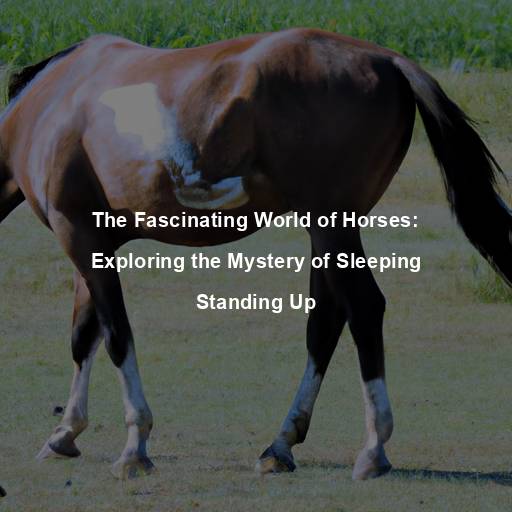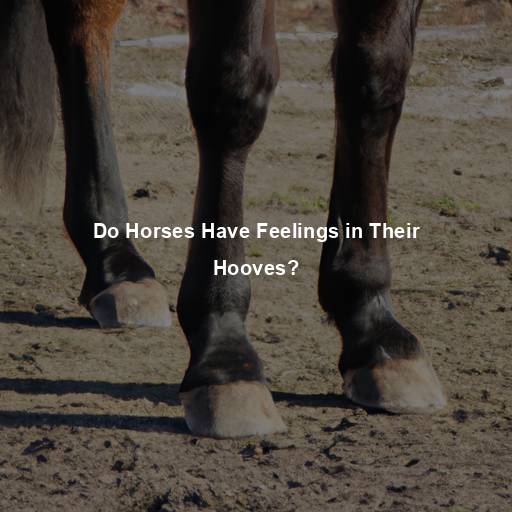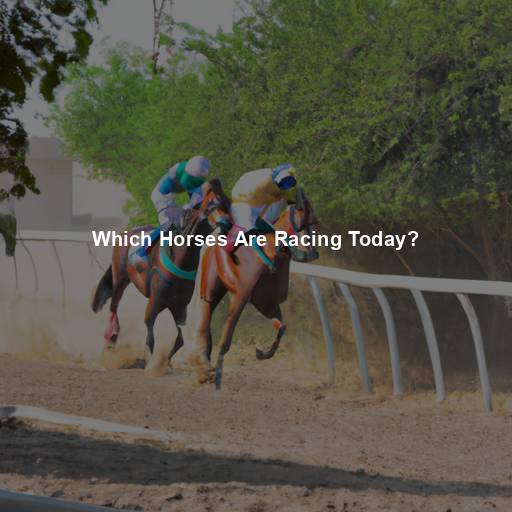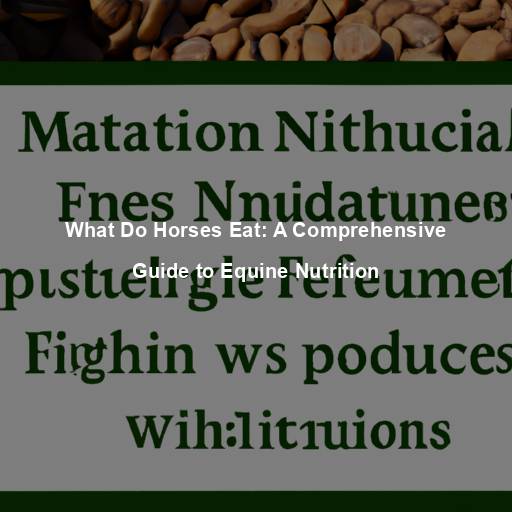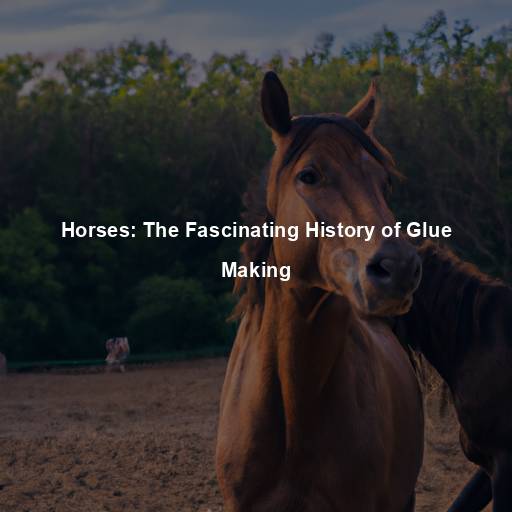Do Horses Inbreed in the Wild?
Last Updated on November 1, 2023 by Evan
Contents
The Natural Behavior of Wild Horses
The Social Structure of Wild Horse Herds
Have you ever wondered about the captivating world of wild horses? They are these fascinating creatures, so full of mystery and resilience, roaming the vast landscapes with a sense of freedom that is truly awe-inspiring. Descendants of their once-domesticated ancestors, these feral horses have unraveled the art of survival in the wild, adapting to their surroundings with an enigmatic grace. One cannot help but be mesmerized by the intricate dynamics of their herd structure, a crucial factor that shapes their breeding patterns and ensures the continuity of their majestic bloodlines.
In the wild, horses live in small family groups called bands. Each band typically consists of a dominant stallion, several mares, and their offspring. The dominant stallion is responsible for protecting the band and ensuring the survival of its members. Within the band, there is usually limited genetic diversity, as the dominant stallion mates with the mares.
Territorial Behavior and Roaming
Within the realm of wild horses, a captivating aspect reveals itself through their territorial behavior, which is an intrinsic part of their existence. Each distinct band meticulously carves out its own distinct domain, a testament to their complex social fabric. This behavior not only promotes a harmonious coexistence but also safeguards against the risks of inbreeding among closely connected individuals. As the journey towards maturity unfolds, younger stallions begin to test the waters, challenging the reigning alpha for control over the group, thus introducing a stirring air of transformation to the genetic composition of the herd.
Wild horses also have a natural instinct to roam and explore new areas. This roaming behavior allows for the exchange of genetic material between different herds, increasing genetic diversity and reducing the likelihood of inbreeding. However, the extent to which wild horses roam and interact with other herds may vary depending on factors such as habitat size and availability of resources.
Factors Influencing Inbreeding in Wild Horses
Population Size and Isolation
In the vast world of wild horses, there is a complex issue that plagues their populations – inbreeding. A puzzling phenomenon, it occurs when the numbers dwindle and the herd becomes smaller. This unfortunate circumstance heightens the likelihood of close relatives mating, resulting in a surge of detrimental genetic traits and a distressing decline in the richness of their gene pool. With perplexity at its core, this matter demands our attention for the sake of preserving the wild horse legacy.
Additionally, the isolation of wild horse populations can further exacerbate the risk of inbreeding. If a population becomes isolated due to geographical barriers or human intervention, the gene pool becomes limited, and the chances of inbreeding become higher.
Human Influence and Habitat Fragmentation
Human activities, such as habitat fragmentation and the construction of fences, can disrupt the natural movement and breeding patterns of wild horses. When their habitat is fragmented, wild horse herds may become isolated from each other, leading to a higher risk of inbreeding within individual herds.
In the grand tapestry of nature, the intricate dance of wild horses is a testament to the delicate equilibrium that exists. However, our well-intentioned actions can sometimes unintentionally disrupt this harmonious flow. Through measures like selective breeding or the relocation of these majestic creatures, the delicate fabric of their genetic diversity can be inadvertently stitched askew. When we introduce horses that share striking resemblances or remove crucial individuals from a herd, we unwittingly set in motion a chain reaction that may unravel the very essence of their natural balance, paving the way for the eerie specter of inbreeding to loom large.
The Consequences of Inbreeding in Wild Horses
Reduced Genetic Diversity
The mingling of genes within a population is a delicate dance that shapes its destiny. However, when proximity blurs the lines of kinship, a perplexing phenomenon unfolds. Inbreeding, drenched in its enigmatic allure, dares to traverse the bounds of genetic diversity. Alas, as this intricate nonconformity takes hold, it unfurls a cascade of inherited mutations and traits, leaving the population teetering on the precipice of compromised fitness and waning adaptability.
Increased Risk of Genetic Disorders
Inbred populations are more prone to genetic disorders due to the accumulation of harmful recessive genes. These disorders can range from physical abnormalities to compromised immune systems, ultimately impacting the survival and well-being of the affected individuals.
Decreased Reproductive Success
In the intricate web of nature’s design, the delicate balance of wild horse populations can sometimes be disrupted by the quiet menace of inbreeding. A sinister shadow lurking within their bloodlines, it can cast its enigmatic spell on these magnificent creatures. Unbeknownst to many, inbreeding can unleash a cascade of consequences, causing a disheartening decline in fertility, birth rates, and the arrival of offspring bearing the weight of genetic abnormalities. As this enigma unfolds, the population size dwindles, and the tapestry of genetic diversity unravels, leaving befuddled researchers searching for solutions to this perplexing puzzle.
Conservation Efforts and Genetic Management
Balancing Genetic Diversity and Preservation
Ensuring the survival and well-being of wild horses is no small feat. Conservation organizations and wildlife management agencies are at the forefront, navigating the complex terrain of monitoring and managing wild horse populations. Through a combination of genetic management techniques, these diligent stewards strive to strike a delicate balance, ever-vigilant in their efforts to minimize the detrimental effects of inbreeding and maintain robust populations that exude genetic diversity. Amidst this intricate dance, they persist, steadfastly committed to securing a bright future for these majestic creatures.
Genetic Testing and Monitoring
Genetic testing and monitoring programs help identify inbred individuals and assess the overall genetic health of wild horse populations. By understanding the genetic makeup of different herds, conservationists can make informed decisions regarding breeding programs and translocation efforts.
Translocation and Reintroduction Programs
In order to tackle the challenges posed by inbreeding, experts have devised translocation and reintroduction initiatives that aim to infuse fresh genetic material and enhance the genetic variety within horse populations. These programs involve the deliberate movement of horses from one herd to another, but their implementation demands meticulous evaluation. Compatibility with the receiving herd and the avoidance of social upheaval or disease transmission are key factors that are thoughtfully considered throughout the process.
Habitat Preservation and Restoration
Preserving and restoring wild horse habitats is crucial in maintaining healthy populations. By ensuring sufficient space and resources for wild horses to roam and interact with other herds, the chances of inbreeding can be reduced. This includes addressing habitat fragmentation, protecting migration corridors, and promoting sustainable land management practices.
Reduced Fitness and Adaptability
Inbreeding depression refers to the negative consequences of inbreeding on the overall fitness and adaptability of a population. As previously mentioned, inbred individuals have a higher likelihood of inheriting harmful recessive genes, which can lead to various health issues and reduced reproductive success. These genetic abnormalities can decrease the overall fitness of the population, making it more vulnerable to environmental changes and decreasing its ability to survive and thrive in the wild.
Increased Susceptibility to Diseases
In the realm of genetics, inbreeding poses a twisted plight for individuals, as their immune systems bear the burden of compromise, rendering them vulnerable to an array of diseases and infections. The constricting grip of reduced genetic diversity places severe constraints on the population’s collective defense mechanisms, impeding their ability to combat the relentless onslaught of pathogens with unwavering resolve. The consequence can be dire, with mortality rates soaring and the already beleaguered population spiraling further into a distressing decline, particularly in the face of emerging ailments and evolving strangeness.
Loss of Adaptability and Resilience
The tapestry of genetics weaves a complex tale of adaptability and survival. Within the intricate threads of a diverse gene pool lie the key to a population’s resilience in the face of an ever-changing world. Like a vibrant symphony of traits and characteristics, genetic diversity offers a repertoire of options, enabling organisms to dance gracefully with shifting environmental melodies.
However, in the shadows of inbreeding, a paradox emerges – a stifling of possibilities, a narrowing of the genetic runway. These vulnerable populations, lacking the mosaic of genetic variation, find themselves stumbling upon the rocky path of adaptation. Barriers arise when faced with habitat transformations, the rhythm of climate altering, or the sudden intrusion of invasive species, jeopardizing the wild horses’ delicate balance on the precipice of extinction.
In this complex saga of survival, the preservation of genetic diversity becomes an urgent symphony, harmonizing the perplexing dance of life and death. A call echoes across the horizon to safeguard the mosaic of possibilities, for within its burst of diversity lies the hope for a resilient future, where wild horses triumph amidst the enigma of an ever-changing world.
The Role of Conservation Organizations
In the intricate world of wild horse preservation, the tireless efforts of conservation organizations and wildlife management agencies are like bold strokes of a master artist’s brush. Their purpose? To safeguard the delicate balance between survival and genetic vitality. Armed with a dazzling array of strategies and techniques, these guardians of biodiversity strive to tame the perils of inbreeding, forging paths towards the elusive oasis of genetic diversity.
Genetic Management and Breeding Programs
A river of knowledge flows through the realm of genetic management, where the intricate tapestry of wild horse populations is carefully woven. Like guardians of destiny, conservationists navigate this enigmatic terrain, armed with the wisdom of genetics. They embark upon a sacred quest to protect the sanctity of species, armed with the power to select life’s partners and alter the course of nature’s very fabric. Through the dance of outbreeding, they forge a path away from the abyss of inbreeding, ensuring vitality and resilience for generations yet to come.
Translocation and Reintroduction Efforts
Translocation and reintroduction programs are important tools in managing genetic diversity in wild horse populations. By carefully selecting individuals from different herds and introducing them to new populations, genetic diversity can be enhanced. However, it is crucial to consider factors such as genetic compatibility, social dynamics, and the potential spread of diseases to ensure the success of these programs.
Engaging the Public in Conservation Efforts
Public awareness and education play a crucial role in the conservation of wild horse populations. By raising awareness about the challenges and importance of genetic diversity, individuals can become advocates for the protection and preservation of these magnificent animals. Engaging the public through educational campaigns, community outreach programs, and partnerships with schools and organizations can foster a sense of responsibility and inspire action.
Promoting Responsible Ownership and Breeding
Horses, whether wild or domesticated, possess a captivating allure that never fails to mesmerize. As we delve into the enigmatic world of equine genetics, we uncover a vast tapestry of diversity that extends far beyond the untamed spirit of wild horse populations. With our pens poised to illuminate the perplexing intricacies of responsible ownership and breeding, we embark on a journey that intertwines education, awareness, and the vital preservation of our majestic equine companions. By shedding light on the significance of genetic diversity, harnessing the power of responsible breeding practices, and unmasking the haunting specter of inbreeding, we venture into uncharted territories to safeguard the very essence of these captivating creatures.
Encouraging Sustainable Land Management Practices
Sustainable land management practices are essential for the preservation of wild horse habitats and the promotion of genetic diversity. By advocating for sustainable land-use policies, conservation organizations can ensure that wild horses have access to suitable habitats with abundant resources. This includes protecting natural grazing areas, preserving water sources, and minimizing habitat fragmentation caused by human activities.
Collaborating with Local Communities
Engaging with local communities that live in close proximity to wild horse habitats is crucial for successful conservation efforts. Collaborating with these communities, understanding their perspectives, and addressing their concerns can foster a sense of ownership and partnership in conservation initiatives. By involving local communities in decision-making processes and providing them with opportunities to participate in conservation activities, a sense of shared responsibility and stewardship can be developed.
The Future of Wild Horse Conservation
Continued Research and Monitoring
As we delve deeper into the intricate world of wild horse genetics and behavior, the need for continuous research and monitoring becomes more apparent. This ongoing exploration is crucial in unraveling the mysteries that shroud these magnificent creatures. Through the study of genetic health and breeding patterns, as well as the assessment of conservation efforts, scientists and conservationists can hone their strategies and adapt to the ever-changing challenges that arise. Furthermore, this research endeavors to shed light on potential threats such as climate change or the invasion of alien species, empowering us to take proactive measures in safeguarding these enigmatic beings.
Enhanced Collaboration and Partnerships
Preserving the majestic wild horses calls for a harmonious symphony of efforts, as diverse as the galloping creatures themselves. We must entwine the hands of government agencies, conservation warriors, researchers, local tribes, and horse devotees, pooling their wisdom and energies. Together, with their combined might, they can unlock a realm where the challenges of preserving habitats, managing genetic diversity, and awakening public consciousness become mere whispers in the wind.
Adaptive Management Strategies
Given the dynamic nature of wild horse populations and their habitats, adaptive management strategies are crucial. Flexibility and the ability to adapt management plans based on new information and changing circumstances are key to ensuring the long-term success of conservation efforts. By continuously evaluating the effectiveness of different approaches and adjusting strategies accordingly, conservationists can make informed decisions and achieve positive outcomes for wild horse populations.
Preserving the untamed spirit of wild horses and safeguarding their genetic richness goes beyond the call of duty for any single entity. Rather, it necessitates a collective weaving together of efforts, where individuals, communities, organizations, and governments unite in shouldering the weight of responsibility. Only by acknowledging the intrinsic value that these majestic creatures bring to our natural heritage and taking resolute strides towards their conservation can we lay the foundation for a future where these noble beings freely grace our ecosystems, leaving us enthralled by their awe-inspiring beauty.
FAQs – Do Horses Inbreed in the Wild?
Do horses inbreed in the wild?
In the wild, horses have a natural instinct to avoid inbreeding as it can lead to genetic problems and reduced survival rates. Within a wild horse herd, dominant stallions will typically prevent their own offspring from breeding with the mares, thereby promoting genetic diversity and preventing inbreeding.
Why is inbreeding problematic for horses?
The intricate dance of genetics in horse populations can give rise to a perplexing conundrum: inbreeding. This controversial practice, shrouded in an enigmatic aura, carries with it the potential for a burst of troubling consequences. With each successive generation, the shadows of genetic disorders emerge, casting doubt upon the vitality and well-being of these majestic creatures. Yet, there is a glimmer of hope amidst the perplexity – by steering clear of inbreeding and embracing genetic diversity, our noble equine companions may find solace in a world where good health and adaptability reign supreme.
Are there any exceptions where horses may inbreed?
In the vast realm of wild horse dynamics, the delicate dance of genetics occasionally unveils perplexing and unexpected circumstances. It is within the remote and secluded landscapes where tales of limited inbreeding weave their intricate threads. Although the majority of wild horses steadfastly steer clear of such unions, when a small band finds itself cut off from the great herd, the clandestine embrace of close kin becomes a possibility. Yet, let it be known that these occurrences are shrouded in rarity, as the untamed equines ardently uphold their natural aversion to inbreeding.
How is inbreeding managed in domestic horse breeding?
In the world of horse breeding, conscientious breeders and equine organizations are well acquainted with the perils that come hand in hand with inbreeding. They tirelessly strive to safeguard a rich tapestry of genes and steer clear of matches between closely related individuals. Through the meticulous study of pedigrees, genetic testing, and the utmost care in selecting suitable mates, they diligently ward off the specter of inbreeding and uphold the all-encompassing well-being and prowess of our beloved domestic horse breeds.
Can inbreeding be harmful to horse populations?
The impact of inbreeding on horse populations, be it in the wild or domesticated, cannot be overlooked. It is perplexing to fathom the long-term consequences that arise from the accumulation of detrimental genetic traits. Reduced fertility, compromised immune systems, diminished vitality, and heightened susceptibility to diseases are just some of the perplexities that can arise. In dire circumstances, the very existence of horse populations hangs in the balance, as they face the threat of decline or local extinctions. Preserving genetic diversity, through mindful breeding practices, emerges as a vital measure for the continued longevity and flourishing of horse populations.


